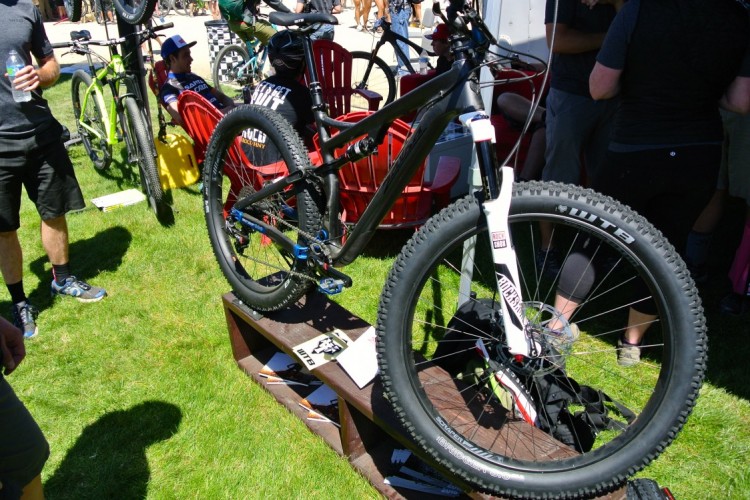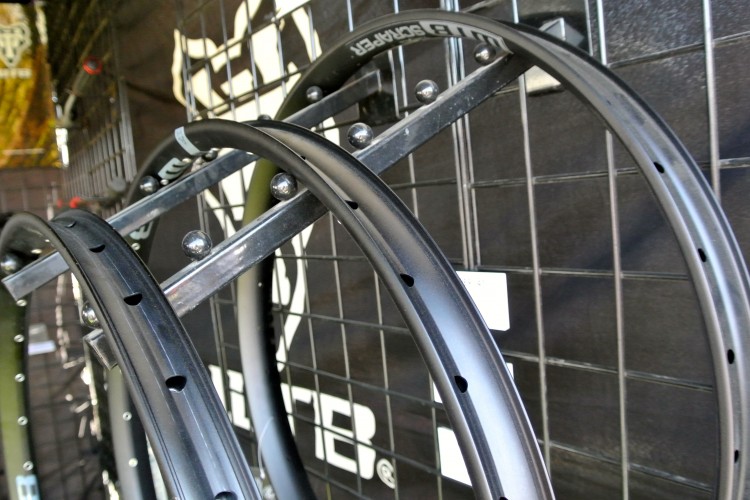
For my final ride at Outerbike, the fine folks at Scott set me up with the Spark 700 Plus Tuned. Our own Chris Daniels did a long-term test on another bike in the Spark range, the 720 Plus. The differences between the bikes lie in the frame material and the build kit. Chris’s tester sported an aluminum frame with a respectable, mid-range component package. The Spark I tested was more of the no expense spared variety.
[see_also id=”203248″][/see_also]
Quick Hits

The Spark 700 Plus Tuned is a gorgeous bike. It has clean, simple lines that help reinforce its purpose: to go fast. After all, this bike is a close cousin to the Spark RC, which has racked up numerous World Cup, World Champs, and Olympic wins. The Spark Plus gets a bump up in travel to 130mm front and 120mm rear over the 100mm/100mm of the race machine.
[see_also id=”195314″][/see_also]

Scott’s design department did a great job with their paint jobs and graphics this season, and the Spark is no exception. There’s a bit of a Gulf Racing thing going on, which is just fine with me. The color matched decals on the rims and the orange highlights on the saddle tie it all together nicely without getting too matchy-matchy.
Moving on to the build kit, it’s a buffet of badassery. We’re talking Kashima coated fork, shock, and dropper from Fox; SRAM’s XX1 Eagle 12-speed drivetrain; and Level Ultimate brakes. Of course, all those goodies come at a price, and in this case, it’s $8,000.
On the Trail

Shuttles were running riders out to the Amasa Back area of Moab for the last day of Outerbike. Since I had a flight to catch later that afternoon, Greg and I were on a mission. We jumped on the first bus and were the first ones pedaling up the road when we got dropped off.
The ride started with about a mile on a slightly uphill gravel road. I used Scott’s Twinloc remote lever, which allows you to completely lockout both the front and rear suspension. With a fully rigid – and extremely light – bike, I flew up the hill to the trailhead. Sadly, Greg sliced open his tire as soon as we got on the singletrack, so I carried on alone while he tried to repair his test bike.
Up I went on the Hymasa trail, climbing towards Captain Ahab. The Spark was snappy and fast–not surprising considering its origins. The geometry put me in a comfortable pedaling position, and the rear end was highly efficient, propelling me onward and upward. However, once the trail started to get chunkier, I found myself regularly smacking pedals into the slickrock. I pride myself on my technical climbing ability, but the overly low BB required extra concentration and perfect timing to prevent strikes. In some situations, this just wasn’t possible, though.

Once I topped out on Hymasa it was time to head down the notorious Captain Ahab trail. This four-mile trail is a rolling descent that features small drops, huge rock rolls, twisty turns, and “don’t look down” sections of exposure. Basically, you have to be on your toes the whole way down. Unfortunately, I crashed on the very first section – through no fault of the bike, mind you – which ended up putting a damper on the rest of the descent. I scraped my forearm up pretty good, but what really hurt was my elbow hitting the slickrock.

For the rest of the descent, I lacked the confidence needed to tackle some of the hairier sections. I rode the majority of the trail, but if I came into a section slightly off line, I pulled the plug rather than trying to make it work. When I was on line, the Spark took every roll and drop in stride.
Final Thoughts
Essentially, the Spark Plus is a trail bike with a racing pedigree. While 130mm/120mm of travel may sound like a lot to an XC racer, Scott retained much of the efficiency of their shorter travel bikes. It’s purposeful rather than plush. I think “taut” is a great way to describe the ride quality.
The frequency of pedal strikes did hamper the climbing experience, so I’d like to see Scott remedy that. Speccing a 140mm travel fork could bring the BB back up to a more reasonable height. If that would change the ride quality too much, Scott could go the route that Pivot chose, which is to use a taller bottom headset cup, which effectively raises the front end. That would be a quick, easy solution, and in my opinion, would lead to a better overall ride experience.
[see_also id=”195314″][/see_also]




















0 Comments